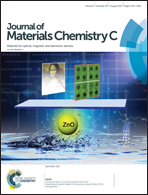Selective and visual detection of a nerve agent mimic by phosphorylation and protonation of quinolin oximes†
Abstract
Nerve agents are highly toxic organophosphorus compounds, and their possible uses in terrorist attacks pose an immediate threat to public safety. Consequently, there is an urgent need to develop reliable and facile methods to detect these lethal chemicals. In this paper, three 6-substituted aminoquinolin oximes with different N-substituents have been constructed as donor–acceptor (D–A) chemosensors for a nerve-agent simulant, diethyl chlorophosphate (DCP). These D–A molecules exhibit a regular change in intramolecular charge transfer (ICT) character with the donating ability of the 6-amine. The hydroxyl of the oxime, as the active site, can be rapidly phosphorylated by DCP via nucleophilic substitution to the product HCl, which enables protonation at the nitrogen of the quinoline. The resulting product exhibits a longer wavelength of ICT emission relative to the corresponding sensor. Consequently, the three sensors respond to DCP in a ratiometric fluorescence mode. Among the three sensors, NA-p3 displays the most remarkable fluorescence change and the lowest limit of detection (21 nM) with DCP in solution. Furthermore, a facile test strip with NA-p3 has been fabricated that can achieve visual detection of DCP vapor and discriminate between DCP vapor and acidic gas in air.



 Please wait while we load your content...
Please wait while we load your content...